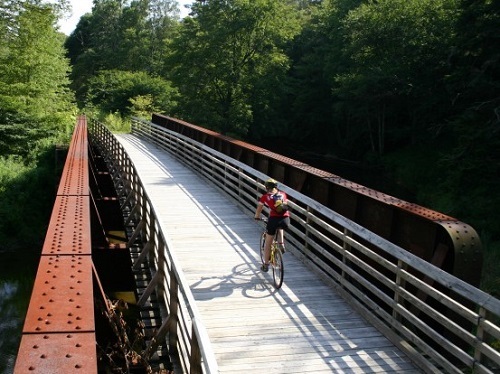The Rails-to-Trails Conservancy or RTC recently launched a new national effort aimed at creating a “new community” where public leaders, advocates, and transportation professionals can come together to advance the development of trails and other active-transportation networks across the country.
[Above photo by RTC]
Dubbed the TrailNation Collaborative, this new “community effort” seeks to fill what RTC describes as an “unmet need” for peer learning and collective action in order to leverage funding from the $1.2 trillion Infrastructure Investment and Jobs Act or IIJA, enacted in November 2021, to create a connected system of trails, sidewalks, and protected bike lanes in every community in America.
“This momentum is a result of decades of advocacy, the determination of the trail-building community, and the ingenuity it takes to envision a future where trail networks are embraced as fundamental to the quality of the places where we live, work, and play,” said Liz Thorstensen, RTC’s vice president of trail development and primary developer of the TrailNation program, in a statement.
“This is an unprecedented opportunity moment for trail networks,” pointed out Ryan Chao, president of RTC. “Together, the TrailNation Collaborative and its hundreds of change agents will lead a paradigm shift to incorporate trail networks as equitable and essential infrastructure in America.”
The group also noted that national trail use increased 9.5 percent nationwide in 2022, nearly on par with 2020 levels, which was the most significant year for trail use on record, according to its most recent analysis.
Concurrently, the IIJA more than doubles funding for trails – emphasizing the important role trails play in encouraging more walking and biking as climate and equity tools.
Additionally, RTC said the IIJA established a new program that provides dedicated funding for the planning and construction of safe and connected trail and active-transportation networks, and long-distance spine trails, the Active Transportation Infrastructure Investment Program or ATIIP.
Since then, according to RTC, trail, and active transportation networks have proven competitive in the majority of federal transportation programs for which they’re eligible – including in the multimodal RAISE program, where the majority of projects have accounted for the needs of bicyclists and pedestrians, and most recently, the Fiscal Year 2023 Omnibus Appropriations Bill, included project earmarks for trails, walking and biking in 29 states.
Concurrently, state departments of transportation across the country are working to incorporate trails into current and future infrastructure projects under their purview.
For example, in September 2022, the Kentucky Transportation Cabinet began construction on the first phase of a $4.1 million Dawkins Line Rail Trail project in Eastern Kentucky.
Meanwhile, in July 2022, the Connecticut Department of Transportation began work on the Putnam Bridge Trail Connections which, when completed in the fall of 2023, will provide non-motorized access across the Connecticut River by linking the shared used path on the Putnam Bridge to Great Meadow Road in Wethersfield and Naubuc Avenue in Glastonbury.
Out west, a team of Utah State University researchers issued a report in July 2022 detailing how to use the state’s network of historic canal trails as an active transportation solution. That study is poised to help the Utah Department of Transportation and community leaders make decisions about building canal paths and trails.
Additionally, in September 2022, the Tennessee State Parks received the Project Excellence Award from the Society of Outdoor Recreation Professionals for its “Tires to Trails” conducted in collaboration with the Tennessee Department of Transportation; a project that uses recycled tires in the construction of recreation paths.
